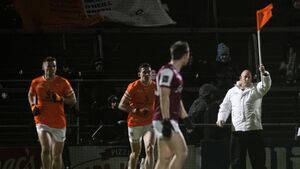Encouraging signs from first weekend of new rules

An orange flag for a two point score was one of the new rules on display at the weekend Photo: ©INPHO/Evan Logan
It is no coincidence that most managers criticising the ‘Rule Enhancements’ over the weekend were losing ones. Armagh’s Kieran McGeeney was unhappy at confusion over whether a 20m free awarded for a 3v3 indiscretion could be brought outside the ‘arc’, as Shane Walsh did, while Derry’s Paddy Tally feels the ’50-metre advancement” for not handing the ball back “doesn’t seem natural.” I agree with the latter actually. It should be sufficient to drop the ball.
For those of us on the winning side at the weekend, it was easier to be positive about the first competitive viewing the FRC’s labours but the general feeling coming out of Newbridge on Saturday night was that we have a more attractive game on our hands. Players seemed to concur.
I don’t always trust my own eyes, though, so how about a few facts first?
Comparing the scoring from this weekend’s thirteen games with the sixteen played in the opening round last year, the number of scores per game increased from 24.9 to 29.8 (treating two pointers as a single score) while the number of goals increased from 1.9 per game to almost 2.4. It’s a small sample size but surely so far so good in terms of entertainment?
It stands to reason that the 3 v 3 rule generates more space for forwards to operate in. Not only that but it encourages teams to look forward and play vertically rather than laterally when they win possession around the middle third.
That in turn encourages more kick passing, and we saw the likes of Brian McLoughlin come to the fore for the Lilywhites in that regard.
The kick-out having to go beyond the arc was another factor in a more attacking, attractive game. Short kick-outs encouraged lateral, slow, possession-based football that bored the behind off all of us.
If Saturday night is anything to go by, we’ll revert to the aerial midfield battles of yore. You’ll see forwards staying up to press the goalkeeper, forcing the long kick out and whichever team wins possession around the middle will see open grass ahead of them to launch a vertical attack.
It will take some time for some teams to change that mindset of looking around for the nearest available sideways handpass, but Kildare already looked like they’d grasped the advantage a quick kick-pass forward can have when they gobble up ball in the middle.
The big issue I’d have is with the so-called 12 v 11 overload in favour of attacking teams. With goalkeepers allowed into the opposing half it creates an unfair advantage in my view. We saw Niall Morgan utilise that overload to create both Tyrone goals against Derry.
Perhaps I am too much of a traditionalist in this respect but why are we creating a game that suits a small minority of goalkeepers who are as good out the field as they are in goals, perhaps better in some cases (Morgan was rather easily beaten by Conor Glass for Derry’s goal)?
You don’t see goalkeepers in hurling venturing into the opposite half. In soccer, it only happens for late corners if they’re losing. Hockey goalkeepers stay in goals. You don’t see rugby wingers demanding to put into the scrum.
The role is called goalkeeper, as in ‘to keep goal’.
Allowing goalkeepers into the opposite half to create an overload is contrary to the spirit of the role and provides the setting in which the laborious “keep ball” can occur when a team wants to wind down the clock.
But there is risk in goalkeepers venturing forth when three attackers remain up front, some will argue. Yes, and we saw that to a degree with Darragh Kirwan’s goal and more obviously with one of Roscommon’s, but we still saw every goalie take that risk at the weekend, so it’s clearly not a big enough deterrent.
Goalkeepers should have to stay in their arc if we are to reap the benefits of the other ‘enhancements’. If they want to switch to an outfield role there’s nothing stopping them.
Other than that issue, my main gripe would be that there is so much going on in games now with referees carrying the ball into the next parish to the utter confusion of supporters that there needs to be some way of communicating decisions to the crowd.
Otherwise, they’ll disconnect. Surely the fourth official could have a quick word with the local PRO / announcer on the sideline who can relay the reason for a decision to the crowd?
A few tweaks and we could have a right good game on our hands.





